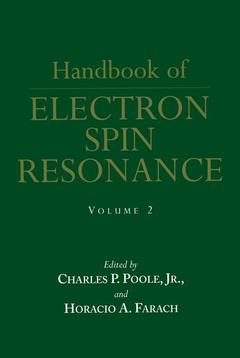Handbook of Electron Spin Resonance, Softcover reprint of the original 1st ed. 1999 Volume 2
Langue : Anglais
Coordonnateurs : Poole Charles P. Jr., Farach Horacio A.

In the first volume, Professors Poole and Farach provided one of the first definitive reference tools for this field. In this second volume, the authors present a comprehensive source for subfields of ESR not covered in the first volume, including: * Sensitivity * Field Swept versus Frequency Swept Spectra * Resonators * Line Shapes * Electron Spin Echo Envelope Modulation * Hamiltonian types and symmetries * ESR Imaging * High Magnetic Fields and High Frequencies. Written by recognized experts in the field, and intended for students and researchers, these handbooks bring together wide-ranging data from diverse disciplines within ESR, and then integrate it into a comprehesive and definitive resource. An invaluable reference for all those involved in ESR research.
I. Sensitivity.- A. Introduction.- B. Minimum Number of Detectable Spins.- 1. Sample and Resonance Condition.- a. Lineshape, Hyperfine Splitting, and $$ S > \frac{1}{2} $$.- b. Power Saturation and Temperature Dependence.- 2. Resonator.- 3. Detection System.- 4. Magnetic Field Modulation.- 5. Additional Factors to Consider in Pulsed Experiments.- C. Predicted Frequency Dependence of ESR Signal, Noise, and Signal-to-Noise Ratio.- 1. Sample.- 2. Resonator.- a. Filling Factor.- b. Quality FactorQ.- c. Signal Intensity at Constant Incident Power.- d. Microwave FieldB1.- 3. Frequency Dependence of Signal Intensity.- a. Case 1. Constant Sample Size, Constant Loop Size.- b. Case 2. Sample and Loop Sizes Scaled as 1 /?0.- c. Case 3. Constant Sample Size, Loop Scaled as 1 /?0.- d. Comparison with NMR.- 4. Noise.- a. Source Noise.- b. Resonator.- c. Detection System.- d. Sample.- D. Performance of Real Systems.- 1. ~9.2 GHz, 3400 G, X-Band.- 2. Frequencies Lower than X-Band.- a. Below 1 GHz, Lossy Samples.- b. 1-4 GHz, L- and S-Bands.- 3. Frequencies Higher than X-Band.- a. 13.7 GHz (P-band).- b. 35 GHz (Q-band).- c. 95 GHz (W-band).- d. 140 GHz.- e. 170 GHz.- f. 250 GHz.- E. Definitions and Derivations.- 1. Definition ofQ?andx”.- 2. Derivation of Fundamental Detection Equation.- 3. Noise Factor for a Series of Amplification Steps.- 4. Frequency Dependence ofQfor LGR, Derivation of Equation (4).- 5. Frequency Dependence of B1Derivation of Equation (6).- Acknowledgments.- References.- II. Field-Swept Versus Frequency-Swept Spectra.- A. Introduction.- B. Lineshapes.- 1. ESR Signal Amplitudes.- 2. Distinction Between Resonance Condition and Resonance Center.- C. Applications.- 1. Adoption of 1/gScaling in Lineshape Function and Linewidth.- 2. Utilization of the Boltzmann Factor.- 3. Relation Between Field Modulation and Frequency Modulation.- 4. Explanation of Echo-Detected Two-Dimensional FT ESR.- D. Concluding Remarks.- References.- III. Resonators.- A. Introduction.- B. Waveguides and Cavities.- C. Coupling Structures.- D. Velocity and Impedance.- E. Rectangular Resonant Cavity.- F. Cylindrical Resonant Cavity.- G. Special Purpose Cavities.- H. Quality and Filling Factors.- References.- IV. Lineshapes.- A. Introduction.- B. Lorentzian and Gaussian Shapes.- C. Moments and Widths of Resonant Lines.- D. Overlapping Resonances.- E. Convolution Shape.- F. Anisotropicg-Factors.- G. Hyperfine Powder Patterns.- H. Small Spin Clusters.- I. Amorphous and Semirandom Distributions.- J. Conduction Electrons.- K. Exchange.- L. Saturation.- References.- V. Electron Spin Echo Envelope Modulation.- A. Introduction.- B. Qualitative Description of the ESEEM Experiment.- C. Comparison of ESEEM and ENDOR.- D. HYSCORE.- E. Outlook.- References.- VI. Transition Series Ions.- A. Introduction.- B. First-Transition Series (3dnIron Group) Ions.- C. Second-and Third-Transition Series (4dnPalladium and5dnPlatinum Group) Ions.- D. Rare-Earth (4f “) Ions.- E. Actinide(5fn)Ions.- F. S-State (3d54d55d54f7) Ions.- References.- VII. Transition Ion HamiltonianS.- A. Introduction.- B. Site Symmetries.- C. Spin Hamiltonians.- References.- Appendix I. Spin Operators and Their Matrix Elements.- Appendix II. Descent of Symmetry.- Appendix III. Site Symmetries of Host Crystals.- VIII. Transition Ion Data Tabulation.- Tabulations.- References.- IX. Evaluation of Spin-Hamiltonian Parameters from Epr Data of Single Crystals.- A. Introduction.- B. Perturbation Approach.- C. Brute-Force Methods.- 1. Variation of One Parameter at a Time.- 2. Variation of Parameters in Subgroups.- D. Least-Squares Fitting (LSF) Method.- 1. Introduction.- 2. Details of the LSF Method.- 3. Calculation of Parameter Errors.- 4. General Strategies to Achieve Convergence.- a. Use of Interpolated Fields.- b. Use of Interpolated Frequencies.- c. Use of Binary Chop.- E. Other Applications of the LSF Method.- 1. Electron-Nuclear Spin-Coupled Systems.- a. Estimation of Initial Values of FS SHPs.- b. Estimation of HFS Parameters.- c. Identification of Energy Levels Participating in Resonance.- d. Construction of the SH Matrix for ENSC Systems.- e. Absolute Signs of Parameters.- 2. Fitting of ENDOR Data.- 3. Angular Variation of EPR Spectra.- a. Computation of Initial Resonant FieldsHr(?).- b. Computation of First and Second Derivatives ofS’with Respect toHRequired in (31).- c. Problems Encountered in the Application of the LSF Method and Their Solutions.- 4. Calculation and Fitting of Line Intensities.- a. Intensity Operator.- b. Fitting of Line Intensities.- c. Normalized Intensity and its Derivatives.- d. Limits of Applicability of the Method.- 5. Evaluation of Noncoincident Anisotropic $${\tilde g^2},{\tilde A^2},\tilde D,\tilde P, and \tilde g_n^2$$ Tensors.- a. Spin Hamiltonian.- b. Eigenvalues.- c. Evaluation of SHP by the LSF Technique.- d. Numerical Evaluation of the Derivatives Required in the LSF Procedure.- e. General Remarks.- F. Discussion.- References.- X. Esr Imaging.- Tabulations.- Acknowledgments.- References.- XI. High Magnetic Fields and High Frequencies.- Tabulations.- Acknowledgments.- References.
Date de parution : 10-2012
Ouvrage de 375 p.
15.5x23.5 cm
Disponible chez l'éditeur (délai d'approvisionnement : 15 jours).
Prix indicatif 210,99 €
Ajouter au panier
© 2024 LAVOISIER S.A.S.



